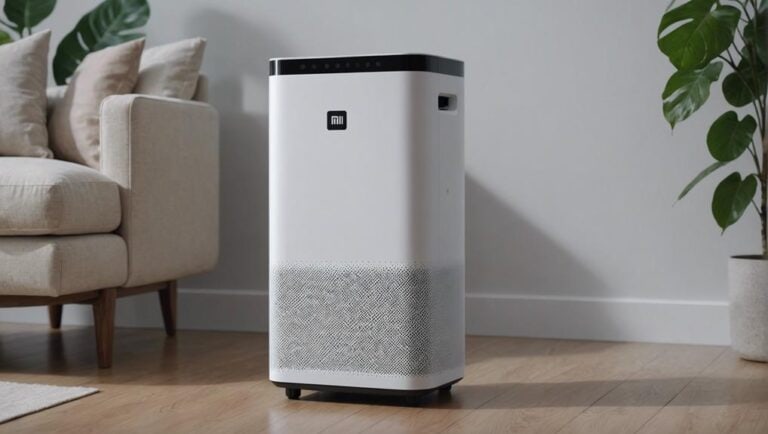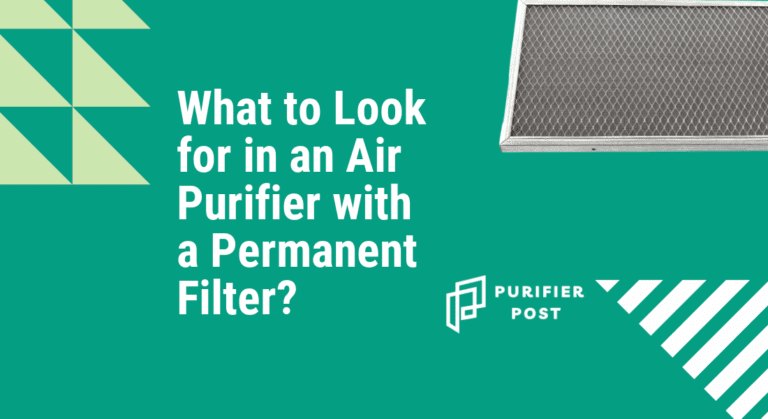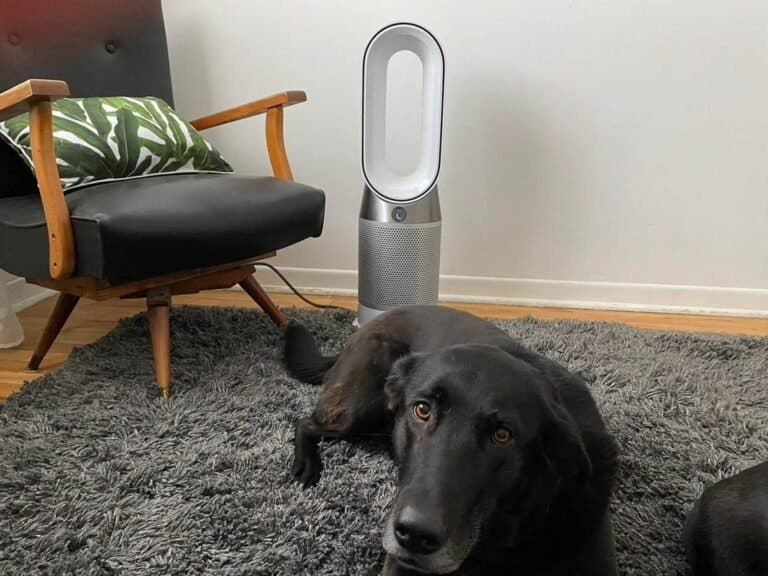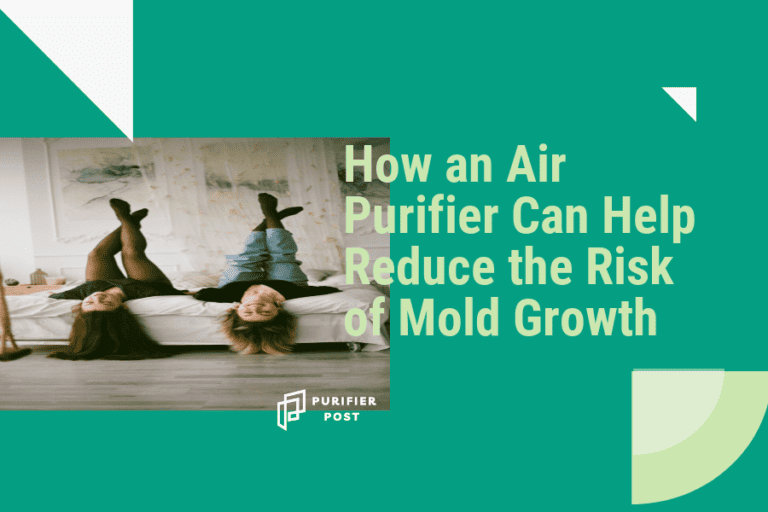Air Purifier Guide for Your Room
When it comes to creating a healthy indoor environment, choosing the right air purifier is essential. From combating allergens to eliminating odors, these devices play a significant role in improving air quality.
But how do you navigate the array of options available and select the best one for your room? Let’s explore the key factors to keep in mind when investing in an air purifier to make an informed decision that benefits both your health and living space.
Benefits of Using an Air Purifier
Using an air purifier enhances indoor air quality by efficiently removing airborne allergens and pollutants. HEPA filters, commonly found in air purifiers, play an important role in capturing particles like dust, pollen, and pet dander, along with viral droplets that may be present in the air.
By reducing indoor air pollution, which can be markedly more contaminated than outdoor air, air purifiers create a healthier environment. Clean filters in air purifiers are essential for decreasing pollutants that can trigger allergies and respiratory problems, ultimately contributing to improved indoor air quality.
Making a well-informed choice when selecting an air purifier can lead to better overall health for our families. It’s essential to take into account the specific needs of our living spaces to ensure that the air purifier effectively targets and eliminates airborne pollutants, providing us with cleaner and fresher indoor air.
Types of Air Purification Technologies
Let’s explore the various air purification technologies available to help you make an informed decision.
From HEPA filters that capture tiny particles to UV-C lights‘ germicidal benefits and the effectiveness of ionizers, each technology offers unique advantages.
Understanding these different methods will guide you in selecting the most suitable air purifier for your needs.
Filter Technology Overview
When considering air purifiers, understanding the various types of filter technologies is essential in selecting the most suitable option for improving indoor air quality. HEPA filters are highly effective mechanical filters that can capture particles as small as 0.3 microns.
Activated carbon filters are great for trapping gases and odors. It’s important to steer clear of technologies like ozone generators, electrostatic precipitators, and ionizers due to potential health risks.
UVGI, PCO, and PECO are other air purification technologies with varying levels of effectiveness in removing contaminants. Choosing the right filter technology plays a pivotal role in addressing specific air quality issues in your room. Make an informed decision based on the specific needs of your indoor environment.
UV-C Light Benefits
Understanding the advantages of UV-C light technology in air purifiers can greatly enhance the effectiveness of your indoor air purification system.
UV-C light effectively destroys microorganisms such as bacteria and viruses by disrupting their DNA structure.
This powerful disinfection method, commonly used in hospitals, can eliminate up to 99.9% of airborne pathogens when correctly applied.
By incorporating UV-C light into your air purifier, you can help reduce the spread of illnesses and create a cleaner indoor environment.
This safe and efficient technology enhances air purification by targeting harmful microorganisms, making it a valuable addition to your living space for a healthier environment.
Ionizer Effectiveness
Ionizers, a type of air purification technology, release charged ions that attach to particles, causing them to fall to surfaces and reducing airborne contaminants. While ionizers can be effective in reducing airborne viruses and bacteria, some models may produce ozone emissions as a byproduct, which can be harmful at high levels. It’s essential to weigh the potential benefits of reducing contaminants against the risks of ozone exposure when selecting an ionizer air purifier. Compared to HEPA filters, ionizers are less efficient in removing particles from the air. Careful consideration of both the advantages and drawbacks of ionizers is crucial for those seeking to maintain a healthy indoor environment.
| Ionizers | HEPA Filters |
|---|---|
| Release charged ions | Highly effective against particles |
| Reduce airborne contaminants | Less effective in particle removal |
| Can produce ozone | Do not emit harmful byproducts |
| Effective against viruses and bacteria | Primarily target particles |
| Consider potential ozone emissions | Consider overall effectiveness |
Factors to Consider When Buying
Taking into account the room size is essential when selecting an air purifier to guarantee peak performance. The Clean Air Delivery Rate (CADR) plays a vital role in efficient air cleaning tailored to the room size.
For those with allergies, checking for allergen-specific CADR ensures effective removal of allergens. It’s important to avoid air purifiers emitting ozone, which can be harmful. Opt for models equipped with HEPA filters or high CADR for effective smoke removal and filtering particles as small as 1 µm.
Considering these factors when purchasing an air purifier ensures that it meets your specific needs, whether it be for allergies, smoke removal, or general air purification. By focusing on CADR, room size, filter type, and potential health concerns like ozone emissions, you can make an informed decision that puts you in control of your indoor air quality.
Maintenance Tips for Air Purifiers
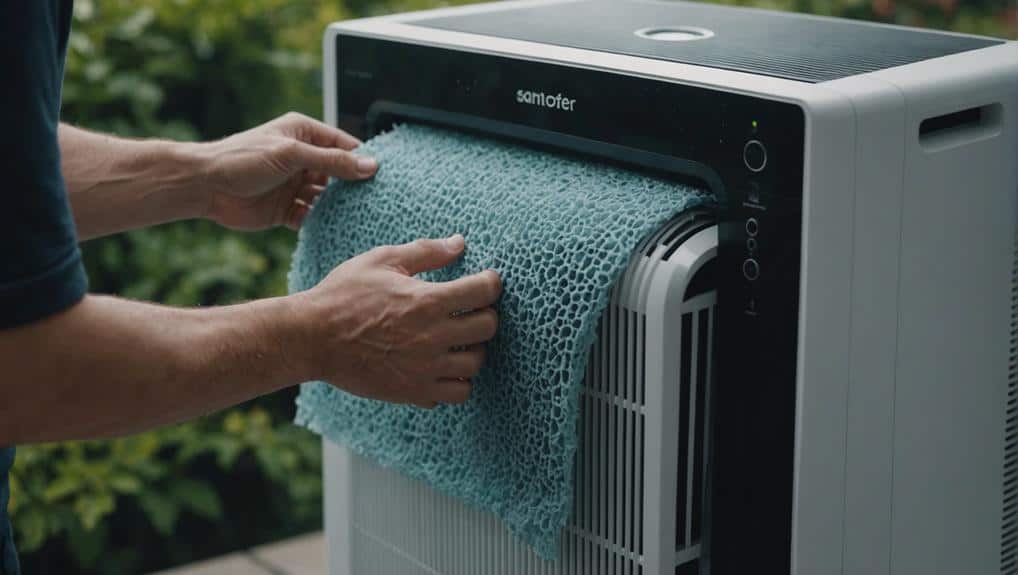
Let’s talk about the essential maintenance tips for air purifiers.
Regularly cleaning or replacing filters, following recommended schedules, and ensuring proper placement are key factors for peak performance.
Filter Replacement Frequency
Regularly checking and replacing air purifier filters is essential for maintaining top air purification efficiency in your room. When it comes to filter replacement frequency, here are some key points to keep in mind:
- Standard filters typically need replacement every 1-3 months for peak performance.
- High-efficiency filters can last up to 12 months before requiring replacement.
- Monitoring the filter condition monthly helps guarantee efficient air purification.
Cleaning Techniques
Ensuring that filters are regularly cleaned or replaced is essential to maintain peak air purifier performance and efficiency. Proper placement of the air purifier in the room is vital for effective air circulation and filtration.
Utilize filter service indicators to stay on top of maintenance needs and adjust fan speeds as necessary to balance noise levels with the best air purification. Following the manufacturer’s maintenance guidelines will help prolong your air purifier’s lifespan. Consider the table below for quick reference on cleaning techniques:
| Maintenance Needs | Action | Benefits |
|---|---|---|
| Filter Replacements | Regularly replace filters | Ensure efficient purification |
| Adjust Fan Speeds | Modify fan speeds as necessary | Optimize noise levels |
| Manufacturer’s Guidelines | Adhere to maintenance instructions | Prolong lifespan |
Odor Elimination Methods
When aiming to maintain excellent air quality in your space, employing effective odor elimination methods through air purifiers is essential. Here are some key points to think about for maintaining ideal indoor air quality:
- Activated Carbon Filters: These filters in air purifiers effectively capture and eliminate odors and volatile organic compounds (VOCs) by adsorbing odor molecules, thereby improving indoor air quality.
- Chemical Bonding and Neutralizing: Activated carbon filters work by chemically bonding with and neutralizing odorous particles in the air, ensuring a fresher environment.
- Regular Replacement: To maintain the effectiveness of odor elimination, it’s important to regularly replace activated carbon filters in your air purifier, especially in spaces with persistent odors like kitchens, pet areas, and bathrooms.
Noise Levels and Sleep Quality
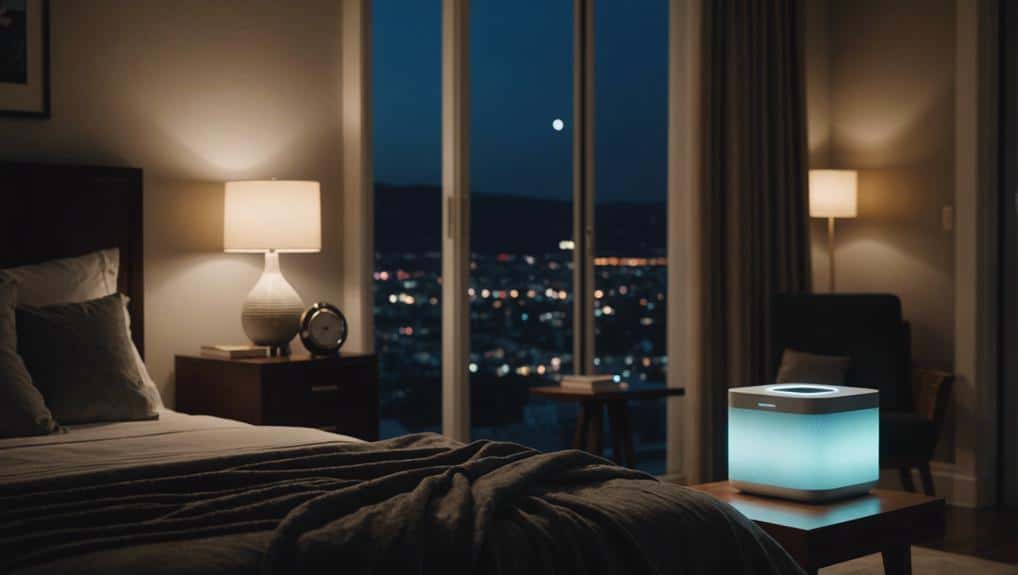
Understanding the impact of air purifier noise levels on sleep quality is essential for creating a restful bedroom environment. When it comes to air purifiers, noise levels are important factors to take into account. Models that operate at around 25-50 decibels on low settings are generally quieter and less likely to disrupt sleep patterns.
For undisturbed rest, it’s recommended to choose an air purifier with a noise level below 60 dB. Some units come equipped with a ‘sleep mode’ feature designed for quiet operation during the night, ensuring a peaceful sleeping environment. Consistent noise above 70 dB from air purifiers can be disruptive and uncomfortable, especially in bedrooms where quiet is necessary for a good night’s sleep.
Opting for a quiet air purifier with noise levels comparable to a hushed conversation (around 40-50 dB) can promote better sleep hygiene and contribute to a more tranquil sleeping environment.
Energy Efficiency and Cost Savings
Improving energy efficiency through proper maintenance and filter usage is essential for maximizing cost savings in air purifier operation. When it comes to energy-efficient air purifiers, the right filter choice and regular maintenance play an important role in reducing energy consumption and saving on costs. Here are three key points to keep in mind:
- Choose HEPA Filters: High-Efficiency Particulate Air (HEPA) filters are known for their superior performance in capturing small particles, which not only improves air quality but also enhances energy efficiency by allowing for better airflow.
- Regular Filter Maintenance: Keeping your air purifier’s filters clean and replacing them as recommended is crucial. Clogged filters can make the air purifier work harder, increasing energy usage and ultimately leading to higher costs.
- Offset Cost with Energy Savings: While investing in efficient filters may have an initial cost, the energy savings they provide over time can offset these expenses, making them a cost-effective choice in the long run.
Recommended Air Purifiers for Bedrooms
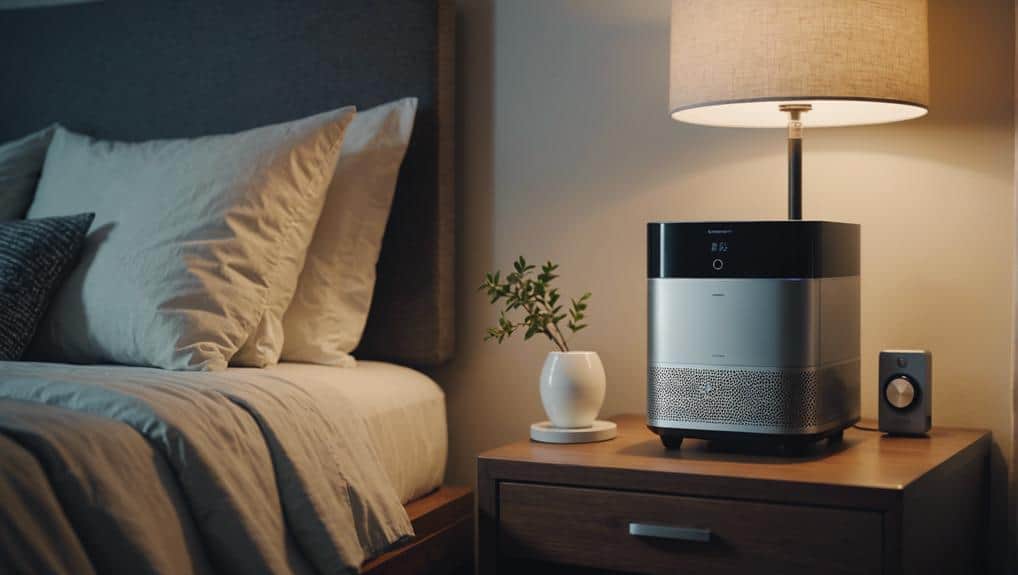
For bedrooms seeking efficient and affordable air purification solutions, the Coway Airmega AP-1512HH Mighty stands out as an ideal choice. The Coway Airmega AP-1512HH Mighty is perfect for bedrooms, playrooms, and living rooms, offering top-tier performance at a reasonable price.
If you prefer a stylish design, the Coway Airmega 200M is a great alternative at $197, available in white and black options.
Another excellent option is the Winix 5500-2, known for its strong performance and unique design, priced at $160 on Amazon and Wayfair.
For those who prioritize aesthetics, the Blueair Blue Pure 311i Max is effective and attractive but comes with higher filter replacement costs, priced at $230 on various platforms.
Lastly, the Levoit Vital 200S offers solid performance and impressive features at $190 on Amazon and $200 on Best Buy.
When it comes to air purifiers for your bedroom, these options provide quality and efficiency to help you create a cleaner and healthier environment.
Conclusion
In conclusion, air purifiers are a valuable investment for improving indoor air quality in your room.
By selecting the right purifier based on room size, filtration technologies, and maintenance needs, you can enjoy cleaner and healthier air.
With low noise levels and energy-efficient features, air purifiers offer a cost-effective solution to address air quality concerns.
Take the necessary steps to guarantee your air purifier is well-maintained for peak performance and a better living environment.

